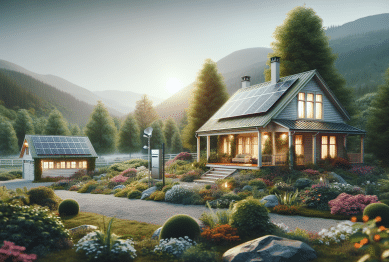Unlock innovative ways to maximize small garden spaces using the latest vertical gardening ideas. This guide explores practical tips, essential design strategies, and plant selection to help create a thriving green space in any home or apartment.
Understanding the Vertical Garden Movement
Vertical gardens have surged in popularity as more people seek creative solutions for limited outdoor and indoor space. By arranging plants upwards, rather than spreading them out horizontally, it’s possible to grow a lush and productive garden even on balconies or small patios. The trend appeals to city dwellers looking to elevate apartment life, as well as homeowners aiming to beautify fences or dull walls. Vertical gardening optimizes growing area while serving as a striking aesthetic feature, blending form and function seamlessly. Whether interested in fresh greens, floral displays, or air-purifying plants, these gardens make it achievable.
The appeal of vertical gardens extends beyond their space-saving properties. They can help improve air quality, provide privacy, and even support urban biodiversity by attracting pollinators to built environments. Modern vertical gardening also leverages hydroponic and modular systems—offering flexibility in design and reducing maintenance. Many eco-friendly enthusiasts and sustainability advocates favor these techniques as they can help reduce the urban heat island effect, cooling the immediate environment efficiently (Source: https://www.epa.gov/heatislands/using-trees-and-vegetation-reduce-heat-islands).
Historical urban gardening methods were limited by space and technology, but today’s vertical gardens are supported by smart irrigation and lightweight panel systems. This makes them more accessible both for seasoned gardeners and beginners. Newcomers can start with simple wall-mounted planters or upcycled containers, building confidence over time. The movement reflects a broader shift toward creative, resource-efficient living, emphasizing adaptability and sustainability within the home environment.
Planning and Designing a Vertical Garden
Planning a vertical garden begins with evaluating space, purpose, and environmental conditions. It’s important to observe sun exposure throughout the day, as light needs will directly influence plant selection. Some vertical structures are ideal for sunny south-facing walls; others thrive in shade. Try visualizing the intended look, whether aiming for a vibrant green wall or a colorful mix of edible herbs and ornamentals. Draw simple sketches to conceptualize placement and layers, keeping in mind how plant heights and colors interact for a pleasing aesthetic. Planning ahead avoids costly mistakes and maximizes long-term satisfaction (Source: https://hort.extension.wisc.edu/articles/vertical-gardening/).
The design phase includes deciding on the right support structure. There are multiple options: wall pockets, trellis grids, shelves, or freestanding panels—all available in various materials. Recycled pallets, mesh frames, and fabric planters are popular for their affordability and eco-friendliness. Irrigation should be integrated or easily accessible, as vertical gardens dry out faster than horizontal beds. Self-watering systems or drip irrigation kits can provide consistent moisture while reducing upkeep. Placement considerations—such as nearby water sources, wind patterns, and ease of access—ensure plants flourish without unnecessary strain.
For renters or those with limited DIY skills, modular vertical gardening kits are readily available and often require minimal installation. Many kits allow forests of greenery to grow without permanent attachment, making them suitable for apartments or temporary living spaces. Plants can be rearranged, swapped, or replaced seasonally—supporting continuous experimentation and creative expression. Aspirational designers might incorporate decorative lighting, integrated shelving, or unusual plant varieties for extra flair. Planning and design together set the foundation for a dynamic, engaging garden space that evolves with the gardener’s needs and creativity.
Choosing the Right Plants for Vertical Success
Plant selection is central to vertical gardening success, and the right choices depend on exposure, climate, and garden goals. Low-maintenance options such as pothos, ferns, and philodendrons thrive in lower light and are especially popular for indoor installations. For sun-drenched locations, succulents, sedum, petunias, and cascading herbs make eye-catching and resilient choices. Edible options like lettuce, strawberries, and trailing tomatoes fit well in small outdoor vertical farms, providing beauty with benefits for the kitchen. Mixing textures and foliage colors lends visual depth and interest, helping to avoid a flat appearance.
Consider climate and microenvironment. Hardy native plants often outperform exotic species, especially where temperature swings or unpredictable weather may pose challenges. Many extension services and botanical gardens publish lists of regionally adapted plants suitable for vertical gardens—for example, herbs like thyme, oregano, and mint for temperate settings, or drought-tolerant succulents for arid locations (Source: https://hgic.clemson.edu/factsheet/vertical-gardening/). Experimentation and observation are key: monitor plant health over time, and don’t hesitate to swap out underperformers for hardier choices as needed.
Different plant varieties also play unique roles within the vertical ecosystem. Vines and climbers, such as ivy or morning glory, rapidly cover trellises and provide natural ‘green curtains.’ Bushier annuals or perennials fill out open space and offer changing seasonal interest. For edible walls, intermixing vegetables and herbs encourages biodiversity and can help limit pest outbreaks. Careful pairing supports both beauty and utility, growing a wall that’s as functional as it is delightful to look at.
Installing and Maintaining a Living Wall
Installation of a vertical garden starts with a secure, weight-bearing support. Use corrosion-resistant fasteners for wall-mounted units, ensuring long-term safety and stability. Lay out planters at comfortable working heights to facilitate both planting and ongoing care. When planting, choose a lightweight but nutrient-rich substrate to minimize wall load while supporting robust root development. Soil blends designed specifically for vertical gardens often include ingredients that aid water retention and drainage. After planting, water each pocket thoroughly and check that drainage is effective.
Ongoing care is where vertical gardening differs from traditional beds. Regular monitoring of moisture levels is crucial, as elevated planters tend to dry out more rapidly. Automated irrigation systems greatly reduce maintenance; otherwise, hand watering may be necessary several times a week in warm weather. Fertilizing should be gentle but consistent, as nutrients leach quickly from small containers. Organic liquid feeds or slow-release granules work well without causing salt build-up. Pruning helps keep growth lush and tidy, while periodic replacement of older plants rejuvenates the display.
Pest management in vertical systems is generally less demanding, as elevated planters are less accessible to soil-dwelling pests. Still, regular inspection for aphids, leaf miners, or fungal spots ensures early intervention. Use natural pest deterrents—like neem oil or insecticidal soap—when needed and encourage beneficial insects whenever possible. Cleaning and replanting sections seasonally prevent disease build-up and keep the vertical garden attractive and healthy year-round (Source: https://www.gardeners.com/how-to/vertical-gardening/5491.html).
Creative Vertical Garden Ideas for Every Space
The versatility of vertical gardens means they can adapt to almost any environment. Indoors, combine hanging pots, wall shelves, and mounted grid systems to cover blank areas with greenery. Living wall art—where succulents or moss are artistically arranged in shadow boxes—provides an eye-catching feature with minimal care. Outdoors, towers of stacked planters, upcycled ladder displays, or rail-mounted troughs make vibrant use of limited patio or balcony space (Source: https://www.rhs.org.uk/plants/types/houseplants/living-walls).
Combine vertical gardening with other trends for even greater impact. Integrating vertical walls with hydroponic technology can boost productivity for edible crops and herbs. Living screens add privacy while filtering air and sound, serving as both architectural and environmental enhancements. Use scented plants, such as jasmine or lavender, to introduce relaxing aromatherapy elements. The possibilities expand as new technologies and materials continue to emerge—each project can be uniquely tailored to personal taste and practical needs.
Budget-friendly DIY options open the practice up to everyone. Reusing wooden pallets, old gutters, or plastic bottles helps create sustainable and individualized installations. With imagination, even small tweaks—like color-coordinated pots or patterned arrangements—make a big difference in the final impression. Vertical gardening is less about rigid rules than about adapting natural beauty to suit your own lifestyle and setting, providing boundless scope for self-expression and experimentation.
Long-term Impact and Considerations for Vertical Gardens
Vertical gardens represent more than a passing trend—they’re an evolving response to modern urban and environmental pressures. By maximizing limited space, they support local food production and greener cities while enhancing quality of life. Community projects featuring living walls can help raise awareness around sustainability and encourage collective care of shared spaces. For homeowners and tenants alike, the mental and physical health benefits of regular exposure to greenery are well established (Source: https://www.ncbi.nlm.nih.gov/pmc/articles/PMC5663018/).
Considerations for long-term vertical garden success include regular upkeep and occasional system upgrades. Structural components may need maintenance or refreshment after several seasons, while plant choices should evolve as knowledge and preferences change. As with any garden, failures are opportunities to learn—what works for one wall may not thrive elsewhere, so patience and adaptability are key. Education resources from cooperative extensions or public gardens provide continued learning and community connection.
Ultimately, vertical gardening offers a way to bring personal vision to life, regardless of location or budget. Whether aiming for lush ornamental displays, productive food walls, or unique art pieces, these living installations continue to redefine what’s possible in limited space. Their positive environmental, social, and psychological impact endures as more people choose to embrace green solutions in the home and beyond.
References
1. U.S. Environmental Protection Agency. (n.d.). Using Trees and Vegetation to Reduce Heat Islands. Retrieved from https://www.epa.gov/heatislands/using-trees-and-vegetation-reduce-heat-islands
2. University of Wisconsin-Madison Division of Extension. (n.d.). Vertical Gardening. Retrieved from https://hort.extension.wisc.edu/articles/vertical-gardening/
3. Clemson Cooperative Extension. (n.d.). Vertical Gardening. Retrieved from https://hgic.clemson.edu/factsheet/vertical-gardening/
4. Gardener’s Supply Company. (n.d.). Vertical Gardening – How to Grow Up, Not Out. Retrieved from https://www.gardeners.com/how-to/vertical-gardening/5491.html
5. Royal Horticultural Society. (n.d.). Living walls: how to plant a living wall. Retrieved from https://www.rhs.org.uk/plants/types/houseplants/living-walls
6. World Health Organization. (2017). Urban green spaces and health. Retrieved from https://www.ncbi.nlm.nih.gov/pmc/articles/PMC5663018/









